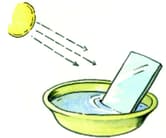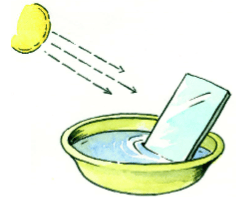Sunlight : White or Coloured
Sunlight : White or Coloured: Overview
This topic covers concepts, such as, Prism, Splitting of White Light by Prism, Rainbow, Colours of Rainbow & Newton's Disc etc.
Important Questions on Sunlight : White or Coloured
Name the device which is used to split white light into seven colours.
(Choose from: Telescope/Glass prism)
Rainbow is a natural phenomenon that is formed due to the dispersion of light.
The angle of deviation of light ray in a prism depends on the angle of prism and angle of _____.
Fill half a bowl with water. Now place the mirror strip in the bowl as shown in the picture. Now keep it facing the sun so that the sun rays fall on the mirror strip. The light reflected by the mirror should now reflect on a white wall.

What can you see on the wall?
Fill half a bowl with water. Now place the mirror strip in the bowl as shown in the picture. Now keep it facing the sun so that the sun rays fall on the mirror strip. The light reflected by the mirror should now reflect on a white wall.

What colours can you see on the wall? Find out the order of the colours and draw its picture.
How many colours are there in a rainbow?
After passing through a prism, white light splits into a band of seven colours.
How many colours are present in the white light?
Read the passage and answer the questions below.
We know that the white light is actually a combination of seven different colours of light. These are violet, indigo, blue, green, yellow, orange and red. All these colours together are called a natural spectrum. A natural spectrum is formed when light scatters at different wavelengths in the atmosphere. These colours are clearly visible when a rainbow is formed. So, if there are seven colours in white light, why does the sky appear mostly blue? Let us understand the reason behind this. Light travels in the form of waves. Blue light has a short wavelength and red light has a long wavelength.
An English physicist, John William Strutt Lord Rayleigh() explained that lights of different wavelengths get scattered when they hit the molecules of hydrogen and oxygen in the atmosphere. Owing to its shorter wavelength, the blue-coloured light gets scattered more than the red one. As such the sky appears blue.
Name the scientist who explained the reason behind the blue colour of the sky.Read the passage and answer the questions below.
We know that the white light is actually a combination of seven different colours of light. These are violet, indigo, blue, green, yellow, orange and red. All these colours together are called a natural spectrum. A natural spectrum is formed when light scatters at different wavelengths in the atmosphere. These colours are clearly visible when a rainbow is formed. So, if there are seven colours in white light, why does the sky appear mostly blue? Let us understand the reason behind this. Light travels in the form of waves. Blue light has a short wavelength and red light has a long wavelength.
An English physicist, John William Strutt Lord Rayleigh(1842-1919) explained that lights of different wavelengths get scattered when they hit the molecules of hydrogen and oxygen in the atmosphere. Owing to its shorter wavelength, the blue-coloured light gets scattered more than the red one. As such the sky appears blue.
Why does the sky appear blue?Read the passage and answer the questions below.
We know that the white light is actually a combination of seven different colours of light. These are violet, indigo, blue, green, yellow, orange and red. All these colours together are called a natural spectrum. A natural spectrum is formed when light scatters at different wavelengths in the atmosphere. These colours are clearly visible when a rainbow is formed. So, if there are seven colours in white light, why does the sky appear mostly blue? Let us understand the reason behind this. Light travels in the form of waves. Blue light has a short wavelength and red light has a long wavelength.
An English physicist, John William Strutt Lord Rayleigh(1842-1919) explained that lights of different wavelengths get scattered when they hit the molecules of hydrogen and oxygen in the atmosphere. Owing to its shorter wavelength, the blue-coloured light gets scattered more than the red one. As such the sky appears blue.
Name the natural spectrum. How it is formed?Name the following:
Sometimes we see this after the rains ______.
Suppose blue light is made to fall on a prism. In how many colours will it split?
How will you prove that light consist of seven colours using newton’s colour disc?
Write the constituent colours of the white light.
How will you prove that light consists of seven colours using newton’s colour disc?
Name the following:
Sometimes we see this after the rains ______
